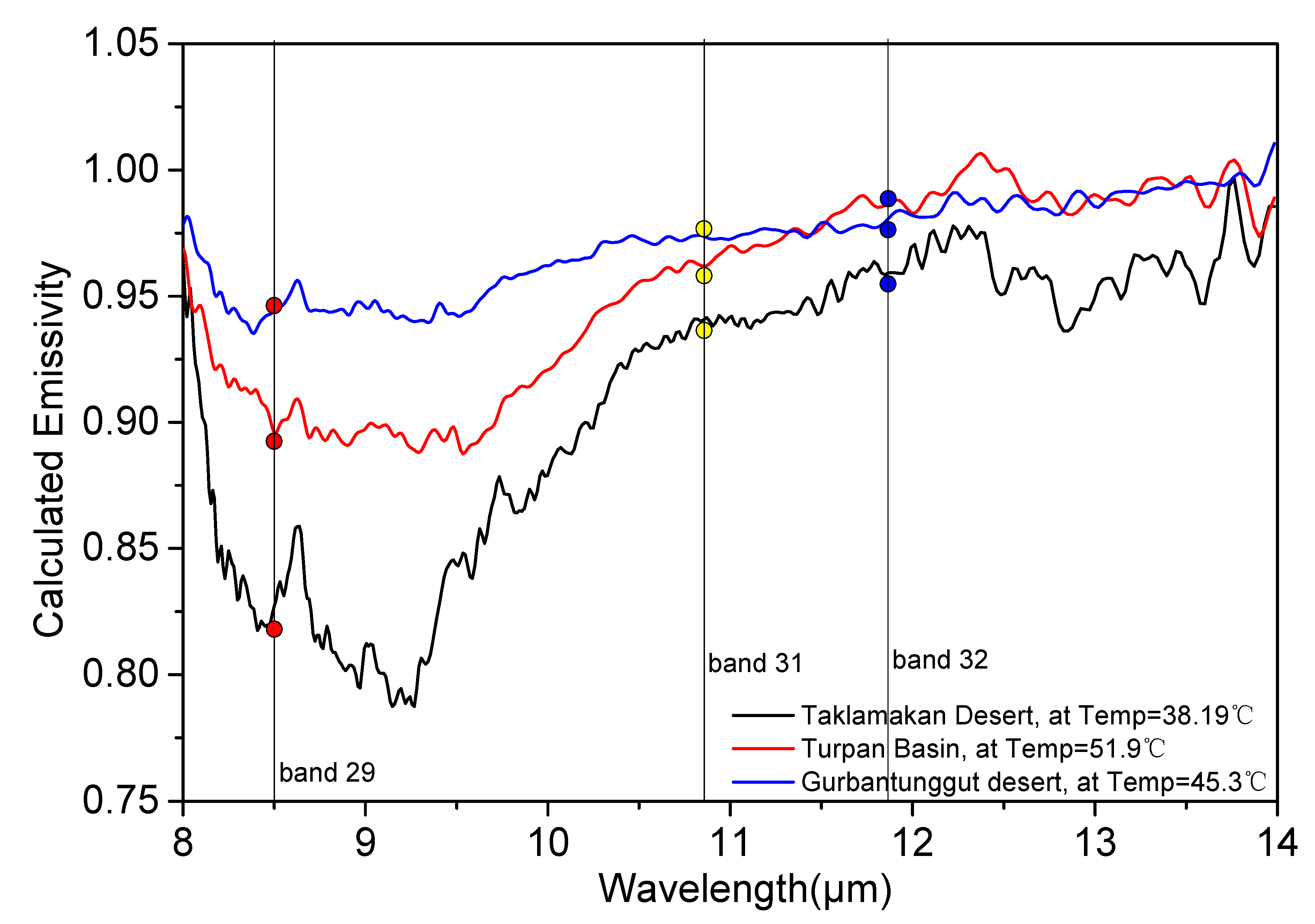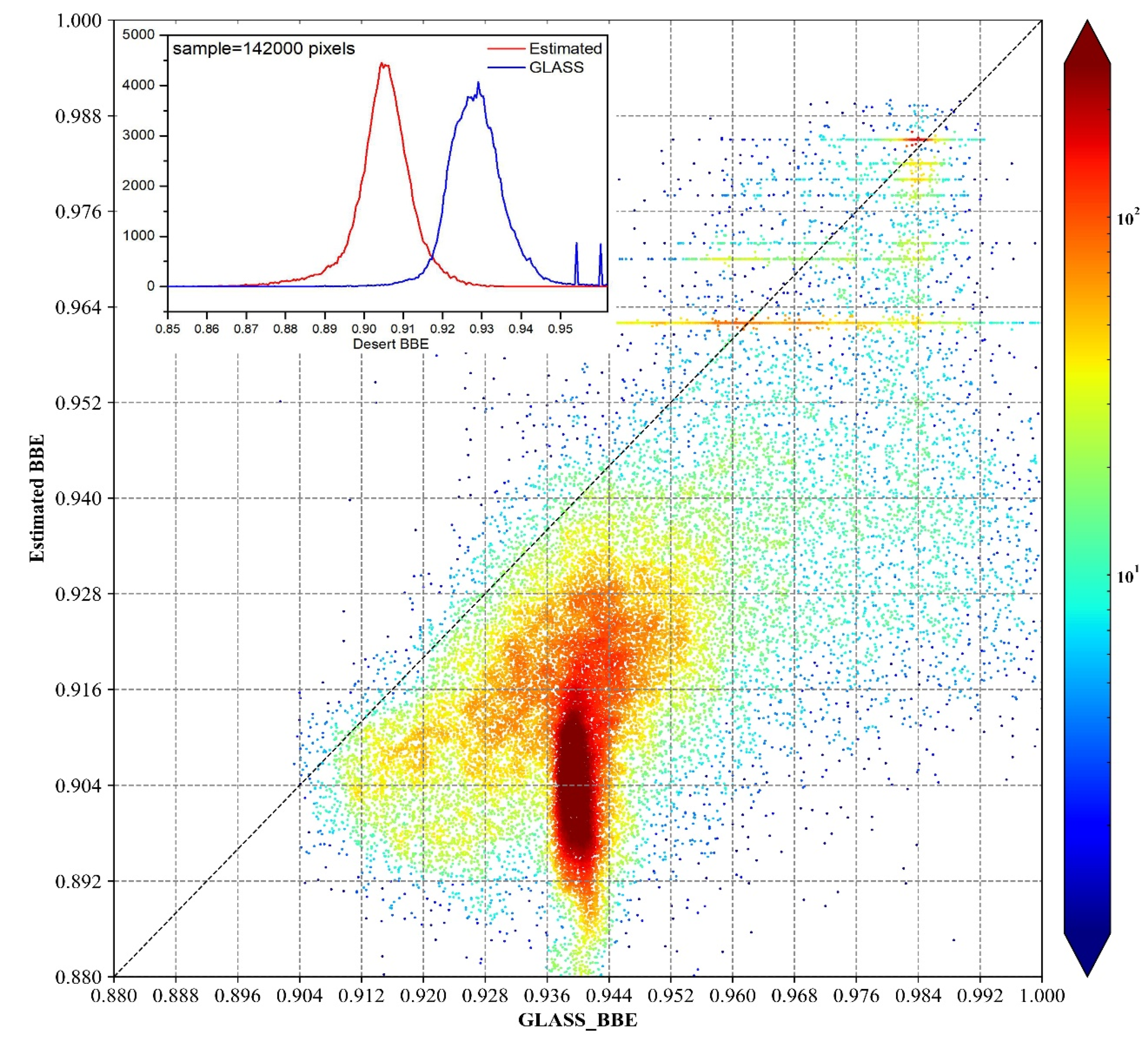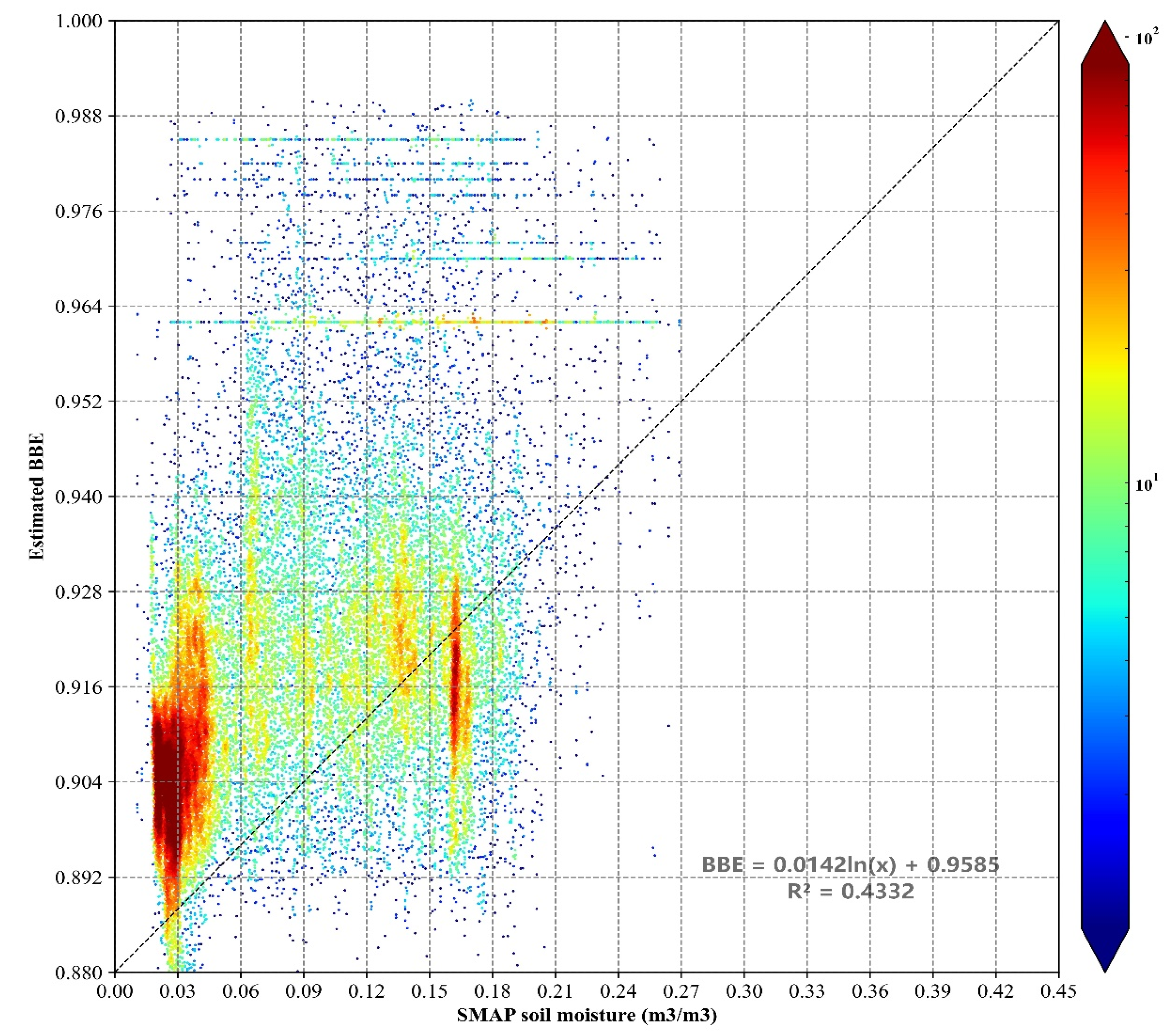A New Linear Relation for Estimating Surface Broadband Emissivity in Arid Regions Based on FTIR and MODIS Products
Abstract
1. Introduction
2. Study Area and Data
2.1. Study Area
2.2. Remote Sensing Data
3. Spectral Data and BBE Calculations
3.1. Spectral Data Measurements
3.2. Converting Spectral Data to BBE
4. Results and Analysis
4.1. BBE Estimation Equation
4.2. Estimating BBE of Arid Region
4.3. Comparison with BBE of GLASS and Model Used Default Value
4.4. Analysis of the Relationship with Land Cover and Soil Moisture
5. Discussion
6. Conclusions
Author Contributions
Funding
Institutional Review Board Statement
Informed Consent Statement
Data Availability Statement
Acknowledgments
Conflicts of Interest
Appendix A
| Label | land Cover Description |
|---|---|
| 0 | No Data |
| 10 | Cropland, rainfed |
| 20 | Cropland, irrigated or post-flooding |
| 30 | Mosaic cropland (>50%)/natural vegetation (tree, shrub, herbaceous cover) (<50%) |
| 40 | Mosaic natural vegetation (tree, shrub, herbaceous cover) (>50%)/cropland (<50%) |
| 50 | Tree cover, broadleaved, evergreen, closed to open (>15%) |
| 60 | Tree cover, broadleaved, deciduous, closed to open (>15%) |
| 70 | Tree cover, needle-leaved, evergreen, closed to open (>15%) |
| 80 | Tree cover, needle-leaved, deciduous, closed to open (>15%) |
| 90 | Tree cover, mixed leaf type (broadleaved and needle-leaved) |
| 100 | Mosaic tree and shrub (>50%)/herbaceous cover (<50%) |
| 110 | Mosaic herbaceous cover (>50%)/tree and shrub (<50%) |
| 120 | Shrubland |
| 130 | Grassland |
| 140 | Lichens and mosses |
| 150 | Sparse vegetation (tree, shrub, herbaceous cover) (<15%) |
| 160 | Tree cover, flooded, fresh or brackish water |
| 170 | Tree cover, flooded, saline water |
| 180 | Shrub or herbaceous cover, flooded, fresh/saline/brackish water |
| 190 | Urban areas |
| 200 | Bare areas |
| 210 | Water bodies |
| 220 | Permanent snow and ice |
References
- Gillespie, A.; Rokugawa, S.; Matsunaga, T.; Cothern, J.S.; Hook, S.; Kahle, A.B. A temperature and emissivity separation algorithm for Advanced Spaceborne Thermal Emission and Reflection Radiometer (ASTER) images. IEEE Trans. Geosci. Remote Sens. 1998, 36, 1113–1126. [Google Scholar] [CrossRef]
- Zhou, L.; Dickinson, R.E.; Ogawa, K.; Tian, Y.; Jin, M.; Schmugge, T. Relations between albedos and emissivities from MODIS and ASTER data over North African Desert. Geophys. Res. Lett. 2003, 30, 2026. [Google Scholar] [CrossRef]
- Ogawa, K.; Schmugge, T.; Rokugawa, S. Estimating broadband emissivity of arid regions and its seasonal variations using thermal infrared remote sensing. IEEE Trans. Geosci. Remote Sens. 2008, 46, 334–343. [Google Scholar] [CrossRef]
- Cheng, J.; Liang, S. A disaggregation approach for estimating high spatial resolution broadband emissivity for bare soils from Landsat surface reflectance. Int. J. Dig. Earth 2017, 1, 691–702. [Google Scholar] [CrossRef]
- Becker, F.; Li, Z.L. Temperature independent spectral indices in thermal infrared bands. Remote Sens. Environ. 1990, 32, 17–33. [Google Scholar] [CrossRef]
- Jin, M.; Liang, S. An improved land surface emissivity parameter for land surface models using global remote sensing observations. J. Clim. 2006, 19, 2867–2881. [Google Scholar] [CrossRef]
- Ogawa, K.; Schmugge, T. Mapping surface broadband emissivity of the Sahara desert using ASTER and MODIS data. Earth Interact. 2004, 8, 1–14. [Google Scholar] [CrossRef]
- Bonan, G.B.; Oleson, K.W.; Vertenstein, M.; Levis, S.; Zeng, X.; Dai, Y.; Dickinson, R.E.; Yang, Z. The land surface climatology of the community land model coupled to the NCAR community climate model. J. Clim. 2002, 15, 3123–3149. [Google Scholar] [CrossRef]
- Zhou, L.; Dickinson, R.E.; Tian, Y.; Jin, M.; Ogawa, K.; Yu, H.; Schmugge, T. A sensitivity study of climate and energy balance simulations with use of satellite-based emissivity data over Northern Africa and the Arabian Peninsula. J. Geophys. Res. 2003, 108, 4795–4803. [Google Scholar]
- Liang, S.; Wang, K.; Zhang, X.; Wild, M. Review on estimation of land surface radiation and energy budgets from ground measurement, remote sensing and model simulations. IEEE J. Sel Top. Appl Earth Obs. Remote Sens. 2010, 3, 225–240. [Google Scholar] [CrossRef]
- Sellers, P.J. Modeling the exchanges of energy, water, and carbon between continents and the atmosphere. Science 1997, 275, 502–509. [Google Scholar] [CrossRef]
- Norman, J.M.; Anderson, M.C.; Kustas, W.P. Remote sensing of surface energy fluxes at 101-m pixel resolutions. Water Resour. Res. 2003, 39. [Google Scholar] [CrossRef]
- Chen, F.; Janji, Z.; Mitchell, K. Impact of Atmospheric Surface-layer Parameterizations in the new Land-surface Scheme of the NCEP Mesoscale Eta Model. Boundary Layer Meteorol. 1997, 85, 391–421. [Google Scholar] [CrossRef]
- Chen, F.; Dudhia, J. Coupling an advanced land surface–hydrology model with the Penn State–NCAR MM5 modeling system. Part I: Model description and implementationy. Mon. Weather. Rev. 2001, 129, 569–585. [Google Scholar] [CrossRef]
- Yang, Z.L.; Niu, G.Y.; Mitchell, K.E. The community Noah land surface model with multiparameterization options (Noah-MP): 2. Evaluation over global river basins. J. Geophys. Res. Atmos. 2011, 116. [Google Scholar] [CrossRef]
- French, A.N.; Jacob, F.; Anderson, M.C. Surface energy fluxes with the advanced spaceborne thermal emission and reflection radiometer (ASTER) at the Iowa 2002 SMACEX site (USA). Remote Sens. Environ. 2005, 99, 55–65. [Google Scholar] [CrossRef]
- Dash, P. Land surface temperature and emissivity estimation from passive sensor data: Theory and practice–current trends. Int. J. Remote Sens. 2006, 23, 2563–2594. [Google Scholar] [CrossRef]
- Wilber, A.; Kratz, D.; Gupta, S. Surface Emissivity Maps for Use in Satellite Retrievals of Longwave Radiation; NASA/TP-1999-209362; NASA Langley Technical Report Server; 1999; Available online: http://techreports.larc.nasa.gov/1trs (accessed on 11 November 2018).
- Meng, X.; Cheng, J.; Liang, S. Estimating land surface temperature from Feng Yun-3C/MERSI data using a new land surface emissivity scheme. Remote Sens. 2017, 9, 1247. [Google Scholar] [CrossRef]
- Jiang, G.M.; Li, Z.L.; Nerry, F. Land surface emissivity retrieval from combined mid-infrared and thermal infrared data of MSG-SEVIRI. Remote Sens. Environ. 2006, 105, 326–340. [Google Scholar] [CrossRef]
- Zhou, S.; Cheng, J. Estimation of high spatial-resolution clear-sky land surface-upwelling longwave radiation from VIIRS/S-NPP data. Remote Sens. 2018, 10, 253. [Google Scholar] [CrossRef]
- Borbas, E.E.; Hulley, G.; Feltz, M. The combined ASTER MODIS emissivity over land (CAMEL) part 1: Methodology and high spectral resolution application. Remote Sens. 2018, 10, 643. [Google Scholar] [CrossRef]
- Cheng, J.; Liu, H.; Liang, S. A Framework for Estimating the 30 m Thermal-Infrared broadband emissivity from Landsat surface reflectance data. J. Geophys. Res. Atmos. 2017, 122, 11405–11421. [Google Scholar] [CrossRef]
- Ren, H.; Liang, S.; Yan, G.; Cheng, J. Empirical algorithms to map global broadband emissivities over vegetated surfaces. IEEE Trans. Geosci. Remote Sens. 2013, 51, 2619–2631. [Google Scholar] [CrossRef]
- Glynn, C.H.; Simon, J.H.; Elsa, A.; Nabin, M.; Tanvir, I.; Michael, A. The ASTER global emissivity Dataset (ASTER GED): Mapping Earth’s emissivity at 100 m spatial scale. Geophys. Res. Lett. 2015, 10, 7966–7986. [Google Scholar]
- Cheng, J.; Liang, S.; Dong, L.; Ren, B.; Shi, L. Validation of the Moderate-Resolution Imaging Spectrometer (MODIS) land surface emissivity products over the Taklimakan Desert. J. Appl. Remote Sens. 2014, 8, doi. [Google Scholar] [CrossRef]
- Li, H.Q.; Wu, X.P.; Ali, M.; Huo, W.; Liu, Y. Estimating surface broadband emissivity of the Taklimakan Desert using FTIR and MODIS data. Spectrosc. Spec. Anal. 2015, 26, 2414–2419. [Google Scholar]
- Yalkun, A.; Mamtimin, A.; Liu, S.; Liu, Y. Coefficients optimization of the GLASS broadband emissivity based on FTIR and MODIS data over the Taklimakan Desert. Sci. Rep. 2019, 9, 1–8. [Google Scholar]
- Cheng, J.; Liang, S. Estimating the broadband longwave emissivity of global bare soil from the MODIS shortwave albedo product. J. Geophys. Res. Atmos. 2014, 19, 614–634. [Google Scholar] [CrossRef]
- Jiménez-Muñoz, J.C.; Sobrino, J.A.; Gillespie, A.; Sabol, D.; Gustafson, W.T. Improved land surface emissivities over agricultural areas using ASTER NDVI. Remote Sens. Environ. 2006, 103, 474–487. [Google Scholar] [CrossRef]
- Carlson, T.N.; Ripley, D.A. On the relationship between NDVI, fractional vegetation cover, and leaf area index. Remote Sens. Environ. 1997, 62, 241–252. [Google Scholar] [CrossRef]
- Liu, Y.Q.; Mamtimin, A.; Huo, W. Estimation of the land surface emissivity in the hinterland of Taklimakan Desert. J. Mt. Sci. 2014, 11. [Google Scholar] [CrossRef]
- Cheng, J.; Xiao, Q.; Li, X.; Liu, Q.; Du, Y.M. Multi-layer perceptron neural network based algorithm for simultaneous retrieving temperature and emissivity from hyperspectral FTIR data. Spectrosc. Spec. Anal. 2008, 28, 780–783. [Google Scholar]
- Li, Z.L.; Wu, H.; Wang, N.; Shi, Q.; José, A.; Wan, Z.M.; Tang, B.H. Land surface emissivity retrieval from satellite data. Int. J. Remote Sens. 2012, 34, 3084–3127. [Google Scholar] [CrossRef]
- Hulme, M. Recent climatic change in the world’s drylands. Geophys. Res. Lett. 1996, 23, 61–64. [Google Scholar] [CrossRef]
- Wang, H.; Chen, Y.; Chen, Z. Spatial distribution and temporal trends of mean precipitation and extremes in the arid region, northwest of China, during 1960–2010. Hydrol. Processes 2013, 27, 1807–1818. [Google Scholar] [CrossRef]
- Feng, S.; Fu, Q. Expansion of global drylands under a warming climate. Atmos. Chem. Phys. 2013, 13, 10081–10094. [Google Scholar] [CrossRef]
- Huang, J.; Li, Y.; Fu, C. Dryland climate change: Recent progress and challenges. Rev. Geophys. 2017, 55, 719–778. [Google Scholar] [CrossRef]
- Sun, J.; Zhang, M.; Liu, T. Spatial and temporal characteristics of dust storms in China and its surrounding regions, 1960–1999: Relations to source area and climate. J. Geophys. Res. Atmos. 2001, 106, 10325–10333. [Google Scholar] [CrossRef]
- Yang, Y.; Zhao, C.; Han, M. Temporal patterns of shrub vegetation and variation with precipitation in Gurbantunggut Desert, Central Asia. Adv. Meteorol. 2015, 2015. [Google Scholar] [CrossRef]
- Bothe, O.; Fraedrich, K.; Zhu, X. Precipitation climate of Central Asia and the large-scale atmospheric circulation. Theor. Appl. Climatol. 2012, 108, 345–354. [Google Scholar] [CrossRef]
- Zhou, X.; Lei, W. Hydrological interactions between oases and water vapor transportation in the Tarim Basin, northwestern China. Sci. Rep. 2018, 8, 13431. [Google Scholar] [CrossRef]
- Liang, S. An optimization algorithm for separating land surface temperature and emissivity from multispectral thermal infrared imagery. IEEE Trans. Geosci. Remote Sens. 2001, 39, 264–274. [Google Scholar] [CrossRef]
- Wan, Z.; Li, Z. A physics-based algorithm for retrieving land-surface emissivity and temperature from EOS/MODIS data. IEEE Trans. Geosci. Remote Sens. 1997, 35, 980–996. [Google Scholar]
- Petitcolin, F.; Vermote, E. Land surface reflectance, emissivity and temperature from MODIS middle and thermal infrared data. Remote Sens. Environ. 2002, 83, 112–134. [Google Scholar] [CrossRef]
- Neinavaz, E.; Roshanak, D.; Andrew, K.; Skidmore, T.; Groen, S. Emissivity of terrestrial materials in the 8–14 μm atmospheric window. Remote Sens. Environ. 1992, 42, 83–106. [Google Scholar]
- Darvishzadeh, R.; Skidmore, A.; Atzberger, C.; Wieren, S. Estimation of vegetation LAI from hyperspectral reflectance data: Effects of soil type and plant architecture. Int. J. Appl. Earth Obs. 2008, 10, 358–373. [Google Scholar] [CrossRef]
- Plummer, S.; Lecomte, P.; Doherty, M. The ESA climate change initiative (CCI): A European contribution to the generation of the global climate observing system. Remote Sens. Environ. 2017, 203, 2–8. [Google Scholar] [CrossRef]
- Li, H.; Zhang, H.; Mamtimin, A. A New Land-Use dataset for the weather research and forecasting (WRF) Model. Atmosphere 2020, 11, 350. [Google Scholar] [CrossRef]
- Zhang, R.; Kim, S.; Sharma, A. A comprehensive validation of the SMAP Enhanced Level-3 Soil Moisture product using ground measurements over varied climates and landscapes. Remote Sens. Environ. 2019, 223, 82–94. [Google Scholar] [CrossRef]
- Korb, A.R.; Salisbury, J.W.; Aria, D.M. Thermal-infrared remote sensing and Kirchhoff’s law: 2. Field measurements. J. Geophys. Res. 1999, 104, 15339–15350. [Google Scholar] [CrossRef]
- Borel, C.C. Surface emissivity and temperature retrieval for a hyperspectral sensor. IGARSS 1998. Sensing and Managing the Environment. In Proceedings of the 1998 IEEE International Geoscience and Remote Sensing, Seattle, WA, USA, 6–10 July 1998; Volume 1, pp. 546–549. [Google Scholar] [CrossRef]
- Cheng, J.; Liang, S. Estimating global land surface broadband thermal-infrared emissivity from the advanced very high-resolution radiometer optical data. Int. J. Digit. Earth 2013, 6 (Suppl. 1), 34–49. [Google Scholar] [CrossRef]
- Zhou, D.K.; Larar, A.M.; Liu, X. Global land surface emissivity retrieved from satellite ultraspectral IR measurements. IEEE Trans. Geosci. Remote Sens. 2010, 49, 1277–1290. [Google Scholar] [CrossRef]
- Tang, B.H.; Wu, H.; Li, C.; Li, Z.L. Estimation of broadband surface emissivity from narrowband emissivities. Opt. Express. 2011, 19, 185–192. [Google Scholar] [CrossRef] [PubMed]
- Tang, B.H.; Shao, K.; Li, Z.L. An improved NDVI-based threshold method for estimating land surface emissivity using MODIS satellite data. Int. J. Remote Sens. 2015, 36, 1–15. [Google Scholar] [CrossRef]
- Li, J.; Li, J.; Weisz, E.; Zhou, D.K. Physical retrieval of surface emissivity spectrum from hyperspectral infrared radiances. Geophys. Res. Lett. 2007, 34. [Google Scholar] [CrossRef]
- Cheng, J.; Liang, S.; Verhoef, W. Estimating the hemispherical broadband longwave emissivity of global vegetated surfaces using a radiative transfer model. IEEE Trans. Geosci. Remote Sens. 2015, 54, 905–917. [Google Scholar] [CrossRef]
- Stathopoulou, M.; Cartalis, C.; Petrakis, M. Integrating Corine Land Cover data and Landsat TM for surface emissivity definition: Application to the urban area of Athens, Greece. Int. J. Remote Sens. 2007, 28, 3291–3304. [Google Scholar] [CrossRef]
- Hulley, G.; Veraverbeke, S.; Hook, S. Thermal-based techniques for land cover change detection using a new dynamic MODIS multispectral emissivity product (MOD21). Remote Sens. Environ. 2014, 140, 755–765. [Google Scholar] [CrossRef]
- Mira, M.; Valor, E.; Boluda, R. Influence of soil water content on the thermal infrared emissivity of bare soils: Implication for land surface temperature determination. J. Geophys. Res. Earth. 2007, 112. [Google Scholar] [CrossRef]








| Statistic Index | Equation (9) | Equation (10) | Equation (11) |
|---|---|---|---|
| R2 | 0.83 | 0.88 | 0.94 |
| RMSE | 0.17 | 0.1 | 0.08 |
| Bias | 0.14 | 0.09 | −0.007 |
Publisher’s Note: MDPI stays neutral with regard to jurisdictional claims in published maps and institutional affiliations. |
© 2021 by the authors. Licensee MDPI, Basel, Switzerland. This article is an open access article distributed under the terms and conditions of the Creative Commons Attribution (CC BY) license (https://creativecommons.org/licenses/by/4.0/).
Share and Cite
Li, H.; Liu, Z.; Mamtimin, A.; Liu, J.; Liu, Y.; Ju, C.; Zhang, H.; Gao, Z. A New Linear Relation for Estimating Surface Broadband Emissivity in Arid Regions Based on FTIR and MODIS Products. Remote Sens. 2021, 13, 1686. https://doi.org/10.3390/rs13091686
Li H, Liu Z, Mamtimin A, Liu J, Liu Y, Ju C, Zhang H, Gao Z. A New Linear Relation for Estimating Surface Broadband Emissivity in Arid Regions Based on FTIR and MODIS Products. Remote Sensing. 2021; 13(9):1686. https://doi.org/10.3390/rs13091686
Chicago/Turabian StyleLi, Huoqing, Zonghui Liu, Ali Mamtimin, Junjian Liu, Yongqiang Liu, Chenxiang Ju, Hailiang Zhang, and Zhibo Gao. 2021. "A New Linear Relation for Estimating Surface Broadband Emissivity in Arid Regions Based on FTIR and MODIS Products" Remote Sensing 13, no. 9: 1686. https://doi.org/10.3390/rs13091686
APA StyleLi, H., Liu, Z., Mamtimin, A., Liu, J., Liu, Y., Ju, C., Zhang, H., & Gao, Z. (2021). A New Linear Relation for Estimating Surface Broadband Emissivity in Arid Regions Based on FTIR and MODIS Products. Remote Sensing, 13(9), 1686. https://doi.org/10.3390/rs13091686







